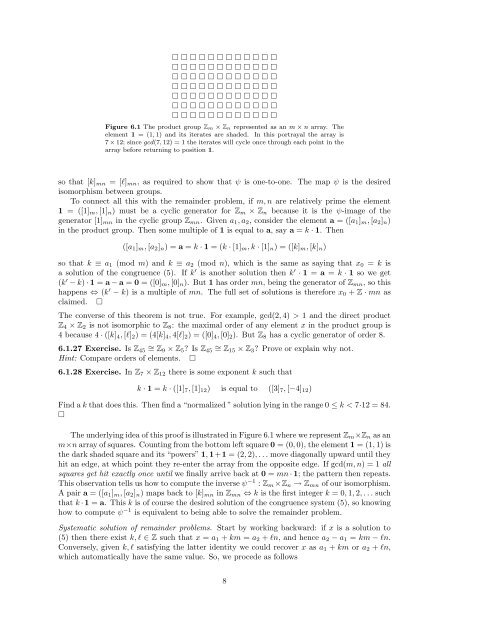Algebra I: Section 6. The structure of groups. 6.1 Direct products of ...
Algebra I: Section 6. The structure of groups. 6.1 Direct products of ...
Algebra I: Section 6. The structure of groups. 6.1 Direct products of ...
Create successful ePaper yourself
Turn your PDF publications into a flip-book with our unique Google optimized e-Paper software.
� � � � � � � � � � � �<br />
� � � � � � � � � � � �<br />
� � � � � � � � � � � �<br />
� � � � � � � � � � � �<br />
� � � � � � � � � � � �<br />
� � � � � � � � � � � �<br />
� � � � � � � � � � � �<br />
Figure <strong>6.</strong>1 <strong>The</strong> product group Zm × Zn represented as an m × n array. <strong>The</strong><br />
element 1 = (1, 1) and its iterates are shaded. In this portrayal the array is<br />
7 × 12; since gcd(7, 12) = 1 the iterates will cycle once through each point in the<br />
array before returning to position 1.<br />
so that [k]mn = [ℓ]mn, as required to show that ψ is one-to-one. <strong>The</strong> map ψ is the desired<br />
isomorphism between <strong>groups</strong>.<br />
To connect all this with the remainder problem, if m, n are relatively prime the element<br />
1 = ([1]m, [1]n) must be a cyclic generator for Zm × Zn because it is the ψ-image <strong>of</strong> the<br />
generator [1]mn in the cyclic group Zmn. Given a1, a2, consider the element a = ([a1]m, [a2]n)<br />
in the product group. <strong>The</strong>n some multiple <strong>of</strong> 1 is equal to a, say a = k · 1. <strong>The</strong>n<br />
([a1]m, [a2]n) = a = k · 1 = (k · [1]m, k · [1]n) = ([k]m, [k]n)<br />
so that k ≡ a1 (mod m) and k ≡ a2 (mod n), which is the same as saying that x0 = k is<br />
a solution <strong>of</strong> the congruence (5). If k ′ is another solution then k ′ · 1 = a = k · 1 so we get<br />
(k ′ − k) ·1 = a −a = 0 = ([0]m, [0]n). But 1 has order mn, being the generator <strong>of</strong> Zmn, so this<br />
happens ⇔ (k ′ − k) is a multiple <strong>of</strong> mn. <strong>The</strong> full set <strong>of</strong> solutions is therefore x0 + Z · mn as<br />
claimed. �<br />
<strong>The</strong> converse <strong>of</strong> this theorem is not true. For example, gcd(2, 4) > 1 and the direct product<br />
Z4 × Z2 is not isomorphic to Z8: the maximal order <strong>of</strong> any element x in the product group is<br />
4 because 4 · ([k]4, [ℓ]2) = (4[k]4, 4[ℓ]2) = ([0]4, [0]2). But Z8 has a cyclic generator <strong>of</strong> order 8.<br />
<strong>6.</strong>1.27 Exercise. Is Z45 ∼ = Z9 × Z5? Is Z45 ∼ = Z15 × Z3? Prove or explain why not.<br />
Hint: Compare orders <strong>of</strong> elements. �<br />
<strong>6.</strong>1.28 Exercise. In Z7 × Z12 there is some exponent k such that<br />
k · 1 = k · ([1]7, [1]12) is equal to ([3]7, [−4]12)<br />
Find a k that does this. <strong>The</strong>n find a “normalized ” solution lying in the range 0 ≤ k < 7·12 = 84.<br />
�<br />
<strong>The</strong> underlying idea <strong>of</strong> this pro<strong>of</strong> is illustrated in Figure <strong>6.</strong>1 where we represent Zm×Zn as an<br />
m×n array <strong>of</strong> squares. Counting from the bottom left square 0 = (0, 0), the element 1 = (1, 1) is<br />
the dark shaded square and its “powers” 1,1+1 = (2, 2), . . . move diagonally upward until they<br />
hit an edge, at which point they re-enter the array from the opposite edge. If gcd(m, n) = 1 all<br />
squares get hit exactly once until we finally arrive back at 0 = mn ·1; the pattern then repeats.<br />
This observation tells us how to compute the inverse ψ −1 : Zm ×Zn → Zmn <strong>of</strong> our isomorphism.<br />
A pair a = ([a1]m, [a2]n) maps back to [k]mn in Zmn ⇔ k is the first integer k = 0, 1, 2, . . . such<br />
that k ·1 = a. This k is <strong>of</strong> course the desired solution <strong>of</strong> the congruence system (5), so knowing<br />
how to compute ψ −1 is equivalent to being able to solve the remainder problem.<br />
Systematic solution <strong>of</strong> remainder problems. Start by working backward: if x is a solution to<br />
(5) then there exist k, ℓ ∈ Z such that x = a1 + km = a2 + ℓn, and hence a2 − a1 = km − ℓn.<br />
Conversely, given k, ℓ satisfying the latter identity we could recover x as a1 + km or a2 + ℓn,<br />
which automatically have the same value. So, we procede as follows<br />
8

















